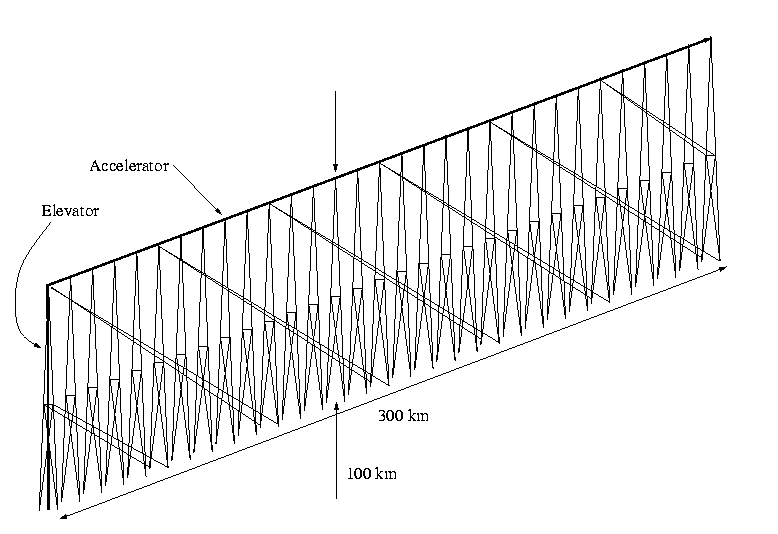
The "pier into space" is 100 km high by 300 long. Due to the curvature of the earth the center is bowed nearly 2 km away from a straignt line; the accelerator track on the top is nearly 5 km longer than the base (even though both end towers are locally vertical). The tower extends completely through the stratosphere (50 km) and mesosphere (90 km) extending into the ionosphere. The density of air at 100 km is less than one millionth that at sea level.
The bracing pictured is purely conjectural -- no detailed design has been done (so far).
Compared to the skyhook, which is just barely possible with even the theoretical best material properties, a tower 100 km high is easy. Flawless diamond, with a compressive strength of 50 GPa, does not even need a taper at all for a 100 km tower; a 100-km column of diamond weighs 3.5 billion newtons per square meter, but can support 50 billion. Even commercially available polycrystalline synthetic diamond with advertised strengths of 5 GPa would work. Of course in practice columns would be tapered so as not to waste material; and the base of the tower would be broadened to account for transverse forces, such as the jet stream. Only the bottom 15 km (i.e. 15%) of the tower lies in the troposphere and would have to be built taking weather into account.
The electromagnetic accelerator along the top might be fairly heavy. In many designs, coils have iron cores; NASA's Marshall prototype weighs 100 pounds per foot. If we allow a tonne per meter, the total weight of the accelerator is 300 thousand tonnes. For comparison, the cruise ship QE2 is 70 thousand tonnes. However, most the weight is (relatively cheap) iron. Note that this entire weight, if it were concentrated in one place, could be supported by a column of currently available polycrystalline diamond less than 80 centimeters on a side.
The overall structure could be openwork like a radio tower, and could have approximately 60 footprints 10 km (30 long x 2 wide) apart on the ground -- if we set aside a hectare for each foot, they only occupy 0.02% of the land under the tower. The footprint foundations would each bear the weight of a small office building, no great technical challenge.
One of the interesting challenges in designing the structure is that simple diamond columns only thick enough to support its weight would be too thin to be rigid. Two strategies which can be brought to bear are truss structures and thin shells inflated for stiffness. At higher altitudes hydrogen could be used for inflation, since there is insufficient oxygen for combustion. At altitudes below the tropopause, some attention should be paid to reducing the structure's wind cross section to minimize the effects of hurricanes and the jet stream. It is not inconceivable that the jet stream, or cloud-to-ground voltages, could be used as energy sources.